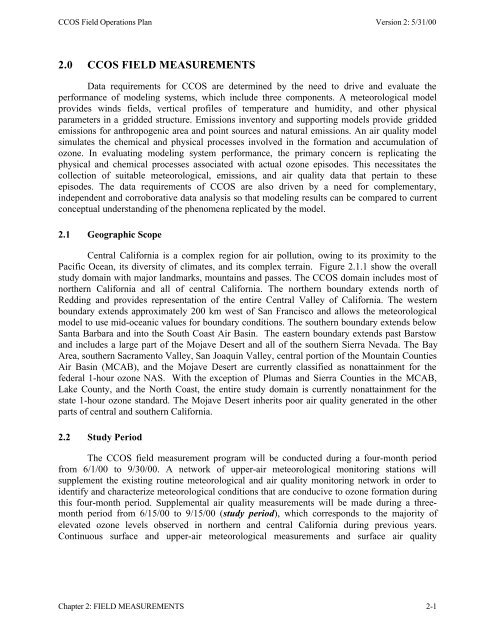Central California Ozone Study (CCOS) - Desert Research Institute
Central California Ozone Study (CCOS) - Desert Research Institute
Central California Ozone Study (CCOS) - Desert Research Institute
You also want an ePaper? Increase the reach of your titles
YUMPU automatically turns print PDFs into web optimized ePapers that Google loves.
<strong>CCOS</strong> Field Operations Plan Version 2: 5/31/00<br />
2.0 <strong>CCOS</strong> FIELD MEASUREMENTS<br />
Data requirements for <strong>CCOS</strong> are determined by the need to drive and evaluate the<br />
performance of modeling systems, which include three components. A meteorological model<br />
provides winds fields, vertical profiles of temperature and humidity, and other physical<br />
parameters in a gridded structure. Emissions inventory and supporting models provide gridded<br />
emissions for anthropogenic area and point sources and natural emissions. An air quality model<br />
simulates the chemical and physical processes involved in the formation and accumulation of<br />
ozone. In evaluating modeling system performance, the primary concern is replicating the<br />
physical and chemical processes associated with actual ozone episodes. This necessitates the<br />
collection of suitable meteorological, emissions, and air quality data that pertain to these<br />
episodes. The data requirements of <strong>CCOS</strong> are also driven by a need for complementary,<br />
independent and corroborative data analysis so that modeling results can be compared to current<br />
conceptual understanding of the phenomena replicated by the model.<br />
2.1 Geographic Scope<br />
<strong>Central</strong> <strong>California</strong> is a complex region for air pollution, owing to its proximity to the<br />
Pacific Ocean, its diversity of climates, and its complex terrain. Figure 2.1.1 show the overall<br />
study domain with major landmarks, mountains and passes. The <strong>CCOS</strong> domain includes most of<br />
northern <strong>California</strong> and all of central <strong>California</strong>. The northern boundary extends north of<br />
Redding and provides representation of the entire <strong>Central</strong> Valley of <strong>California</strong>. The western<br />
boundary extends approximately 200 km west of San Francisco and allows the meteorological<br />
model to use mid-oceanic values for boundary conditions. The southern boundary extends below<br />
Santa Barbara and into the South Coast Air Basin. The eastern boundary extends past Barstow<br />
and includes a large part of the Mojave <strong>Desert</strong> and all of the southern Sierra Nevada. The Bay<br />
Area, southern Sacramento Valley, San Joaquin Valley, central portion of the Mountain Counties<br />
Air Basin (MCAB), and the Mojave <strong>Desert</strong> are currently classified as nonattainment for the<br />
federal 1-hour ozone NAS. With the exception of Plumas and Sierra Counties in the MCAB,<br />
Lake County, and the North Coast, the entire study domain is currently nonattainment for the<br />
state 1-hour ozone standard. The Mojave <strong>Desert</strong> inherits poor air quality generated in the other<br />
parts of central and southern <strong>California</strong>.<br />
2.2 <strong>Study</strong> Period<br />
The <strong>CCOS</strong> field measurement program will be conducted during a four-month period<br />
from 6/1/00 to 9/30/00. A network of upper-air meteorological monitoring stations will<br />
supplement the existing routine meteorological and air quality monitoring network in order to<br />
identify and characterize meteorological conditions that are conducive to ozone formation during<br />
this four-month period. Supplemental air quality measurements will be made during a threemonth<br />
period from 6/15/00 to 9/15/00 (study period), which corresponds to the majority of<br />
elevated ozone levels observed in northern and central <strong>California</strong> during previous years.<br />
Continuous surface and upper-air meteorological measurements and surface air quality<br />
Chapter 2: FIELD MEASUREMENTS 2-1
















